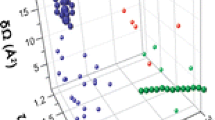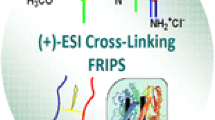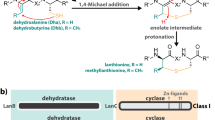Abstract
Lasso peptides are a class of bioactive ribosomally synthesized and post-translationally modified peptides (RiPPs) characterized by a mechanically interlocked topology, where the C-terminal tail of the peptide is threaded and trapped within an N-terminal macrolactam ring. BI-32169 is a class III lasso peptide containing one disulfide bond that further stabilizes the lasso structure. In contrast to its branched-cyclic analog, BI-32169 has higher stability and is known to exert a potent inhibitory activity against the human glucagon receptor. In the present work, tandem mass spectrometry, using collision-induced dissociation (CID) and electron capture dissociation (ECD), and trapped ion mobility spectrometry–mass spectrometry (TIMS-MS) experiments were carried out to evidence specific structural signatures of the two topologies. CID experiments showed similar fragmentation patterns for the two topoisomers, where a part of the C-terminal tail remains covalently linked to the macrolactam ring by the disulfide bond, which cannot clearly constitute a signature of the lasso topology. ECD experiments of BI-32169 showed an increase of hydrogen migration events in the loop region when compared with those of its branched-cyclic topoisomer evidencing specific structural signatures for the lasso topology. The high mobility resolving power of TIMS resulted in the identification of multiple conformations for the protonated species but did not allow the clear differentiation of the two topologies in mixture. When in complex with cesium metal ions, a reduced number of conformations led to a clear identification of the two structures. Experiments reducing and alkylating the disulfide bond of BI-32169 showed that the lasso structure is preserved and heat stable and the associated conformational changes provide new insights about the role of the disulfide bond in the inhibitory activity against the human glucagon receptor.

ᅟ





Similar content being viewed by others
References
Hegemann JD, Zimmermann M, Xie X, Marahiel MA. Lasso peptides: an intriguing class of bacterial natural products. Acc Chem Res. 2015;48(7):1909–19. https://doi.org/10.1021/acs.accounts.5b00156.
Rosengren KJ, Clark RJ, Daly NL, Goeransson U, Jones A, Craik DJ. Microcin J25 has a threaded sidechain-to-backbone ring structure and not a head-to-tail cyclized backbone. J Am Chem Soc. 2003;125:12464–74. https://doi.org/10.1021/ja0367703.
Li Y, Ducasse R, Zirah S, Blond A, Goulard C, Lescop E, et al. Characterization of sviceucin from streptomyces provides insight into enzyme exchangeability and disulfide bond formation in lasso peptides. ACS Chem Biol. 2015;10(11):2641–9. https://doi.org/10.1021/acschembio.5b00584.
Knappe TA, Linne U, Xie X, Marahiel MA. The glucagon receptor antagonist BI-32169 constitutes a new class of lasso peptides. FEBS Lett. 2010;584(4):785–9. https://doi.org/10.1016/j.febslet.2009.12.046.
Tietz JI, Schwalen CJ, Patel PS, Maxson T, Blair PM, Tai HC, et al. A new genome-mining tool redefines the lasso peptide biosynthetic landscape. Nat Chem Biol. 2017;13(5):470–8. https://doi.org/10.1038/nchembio.2319.
Ducasse R, Yan KP, Goulard C, Blond A, Li Y, Lescop E, et al. Sequence determinants governing the topology and biological activity of a lasso peptide, microcin J25. ChemBioChem. 2012;13(3):371–80. https://doi.org/10.1002/cbic.201100702.
Hegemann JD, Zimmermann M, Zhu S, Klug D, Marahiel MA. Lasso peptides from proteobacteria: genome mining employing heterologous expression and mass spectrometry. Biopolymers. 2013;100(5):527–42. https://doi.org/10.1002/bip.22326.
Zimmermann M, Hegemann JD, Xie X, Marahiel MA. The astexin-1 lasso peptides: biosynthesis, stability, and structural studies. Chem Biol. 2013;20(4):558–69. https://doi.org/10.1016/j.chembiol.2013.03.013.
Hegemann JD, Fage CD, Zhu S, Harms K, Di Leva FS, Novellino E, et al. The ring residue proline 8 is crucial for the thermal stability of the lasso peptide caulosegnin II. Mol BioSyst. 2016;12(4):1106–9. https://doi.org/10.1039/c6mb00081a.
Maksimov MO, Pan SJ, James Link A. Lasso peptides: structure, function, biosynthesis, and engineering. Nat Prod Rep. 2012;29(9):996–1006. https://doi.org/10.1039/c2np20070h.
Knappe TA, Linne U, Robbel L, Marahiel MA. Insights into the biosynthesis and stability of the lasso peptide capistruin. Chem Biol. 2009;16(12):1290–8. https://doi.org/10.1016/j.chembiol.2009.11.009.
Potterat O, Wagner K, Gemmecker G, Mack J, Puder C, Vettermann R, et al. BI-32169, a bicyclic 19-peptide with strong glucagon receptor antagonist activity from Streptomyces sp. J Nat Prod. 2004;67(9):1528–31. https://doi.org/10.1021/np040093o.
Jeanne Dit Fouque K, Lavanant H, Zirah S, Hegemann JD, Fage CD, Marahiel MA, et al. General rules of fragmentation evidencing lasso structures in CID and ETD. Analyst. 2018;143(5):1157–70. https://doi.org/10.1039/c7an02052j.
Perot-Taillandier M, Zirah S, Rebuffat S, Linne U, Marahiel MA, Cole RB, et al. Determination of peptide topology through time-resolved double-resonance under electron capture dissociation conditions. Anal Chem. 2012;84(11):4957–64. https://doi.org/10.1021/ac300607y.
Dit Fouque KJ, Moreno J, Hegemann JD, Zirah S, Rebuffat S, Fernandez-Lima F. Identification of lasso peptide topologies using native nanoelectrospray ionization-trapped ion mobility spectrometry-mass spectrometry. Anal Chem. 2018;90(8):5139–46. https://doi.org/10.1021/acs.analchem.7b05230.
Jeanne Dit Fouque K, Afonso C, Zirah S, Hegemann JD, Zimmermann M, Marahiel MA, et al. Ion mobility-mass spectrometry of lasso peptides: signature of a rotaxane topology. Anal Chem. 2015;87(2):1166–72. https://doi.org/10.1021/ac503772n.
Hernandez DR, Debord JD, Ridgeway ME, Kaplan DA, Park MA, Fernandez-Lima F. Ion dynamics in a trapped ion mobility spectrometer. Analyst. 2014;139(8):1913–21. https://doi.org/10.1039/c3an02174b.
Fernandez-Lima FA, Kaplan DA, Suetering J, Park MA. Gas-phase separation using a trapped ion mobility spectrometer. Int J Ion Mobil Spectrom. 2011;14(2–3):93–8.
Fernandez-Lima FA, Kaplan DA, Park MA. Note: integration of trapped ion mobility spectrometry with mass spectrometry. Rev Sci Instrum. 2011;82(12):126106. https://doi.org/10.1063/1.3665933.
McDaniel EW, Mason EA. Mobility and diffusion of ions in gases. Wiley Series in Plasma Physics. New York: Wiley; 1973.
Zubarev RA, Kruger NA, Fridriksson EK, Lewis MA, Horn DM, Carpenter BK, et al. Electron capture dissociation of gaseous multiply-charged proteins is favored at disulfide bonds and other sites of high hydrogen atom affinity. J Am Chem Soc. 1999;121(12):2857–62. https://doi.org/10.1021/ja981948k.
Ganisl B, Breuker K. Does electron capture dissociation cleave protein disulfide bonds? ChemistryOpen. 2012;1(6). https://doi.org/10.1002/open.201200038.
Fouque KJ, Lavanant H, Zirah S, Hegemann JD, Zimmermann M, Marahiel MA, et al. Signatures of mechanically interlocked topology of lasso peptides by ion mobility-mass spectrometry: lessons from a collection of representatives. J Am Soc Mass Spectrom. 2017;28(2):315–22. https://doi.org/10.1007/s13361-016-1524-8.
Jeanne Dit Fouque K, Moreno J, Hegemann JD, Zirah S, Rebuffat S, Fernandez-Lima F. Metal ions induced secondary structure rearrangements: mechanically interlocked lasso vs. unthreaded branched-cyclic topoisomers. Analyst. 2018;143(10):2323–33. https://doi.org/10.1039/c8an00138c.
Salomon RA, Farias RN. Microcin 25, a novel antimicrobial peptide produced by Escherichia coli. J Bacteriol. 1992;174(22):7428–35.
Hegemann JD, Zimmermann M, Xie X, Marahiel MA. Caulosegnins I-III: a highly diverse group of lasso peptides derived from a single biosynthetic gene cluster. J Am Chem Soc. 2013;135(1):210–22. https://doi.org/10.1021/ja308173b.
Hegemann JD, Zimmermann M, Zhu S, Steuber H, Harms K, Xie X, et al. Xanthomonins I-III: a new class of lasso peptides with a seven-residue macrolactam ring. Angew Chem Int Ed Engl. 2014;53(8):2230–4. https://doi.org/10.1002/anie.201309267.
Allen CD, Chen MY, Trick AY, Le DT, Ferguson AL, Link AJ. Thermal unthreading of the lasso peptides astexin-2 and astexin-3. ACS Chem Biol. 2016;11(11):3043–51. https://doi.org/10.1021/acschembio.6b00588.
Funding
This research received a financial support from the National Science Foundation Division of Chemistry, under CAREER award CHE-1654274, with co-funding from the Division of Molecular and Cellular Biosciences to FFL. J. D. H. received a financial support from the Deutsche Forschungsgemeinschaft (DFG Research Fellowship 309199717).
Author information
Authors and Affiliations
Contributions
The manuscript was written through contributions of all authors. All authors have given approval to the final version of the manuscript.
Corresponding author
Ethics declarations
Conflict of interest
The authors declare that they have no competing interests.
Additional information
Published in the topical collection Close-Up of Current Developments in Ion Mobility Spectrometry with guest editor Gérard Hopfgartner.
Publisher’s note
Springer Nature remains neutral with regard to jurisdictional claims in published maps and institutional affiliations.
Electronic supplementary material
ESM 1
(PDF 1239 kb)
Rights and permissions
About this article
Cite this article
Jeanne Dit Fouque, K., Bisram, V., Hegemann, J.D. et al. Structural signatures of the class III lasso peptide BI-32169 and the branched-cyclic topoisomers using trapped ion mobility spectrometry–mass spectrometry and tandem mass spectrometry. Anal Bioanal Chem 411, 6287–6296 (2019). https://doi.org/10.1007/s00216-019-01613-8
Received:
Revised:
Accepted:
Published:
Issue Date:
DOI: https://doi.org/10.1007/s00216-019-01613-8




